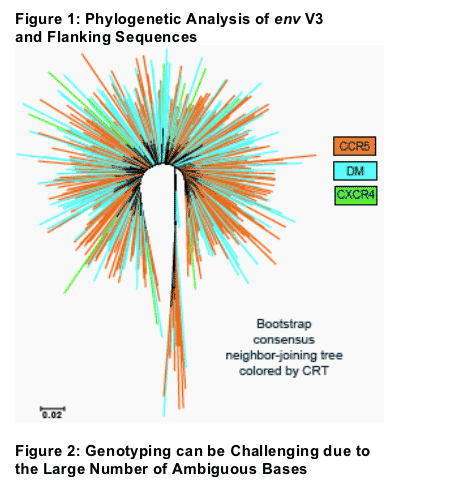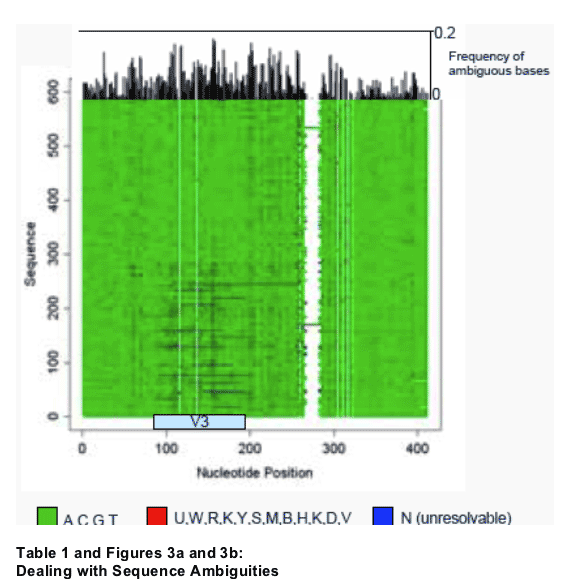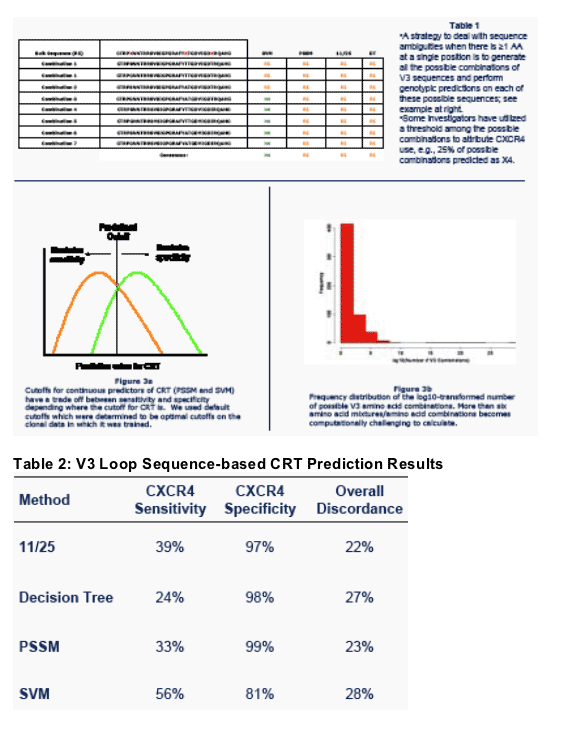 |
 |
 |
| |
Co-Receptor Tropism Predictions Based on V3 Loop Sequence in Antiretroviral-Experienced Patients are Specific but Insensitive for the Detection of CXCR4-using Variants
|
| |
| |
Reported by Jules Levin
11th European AIDS Conference
Madrid, Spain
October 24-27, 2007
E. Coakley, E. Stawiski, J. Whitcomb, S. Fransen, E. Paxinos, J. Toma, T. Wrin, W. Huang, C.J. Petropoulos
Monogram Biosciences, South San Francisco CA USA
AUTHOR RESULTS
Trofile defined approximately half of the samples as having CXCR4-using HIV, i.e. having X4 or Dual/Mixed tropism
Tropism predictions used a combinatorial strategy which allowed V3 sequences with mixtures and up to 100 possible sequence combinations to be included. However V3 sequences containing very large numbers of mixtures, i.e., >100 possible combinations, could not be analyzed and were excluded, with loss of 26% of the dataset.
Among the analyzable sequences sensitivity for CXCR4-using HIV was poor (24-56%)
CRT prediction specificities were generally high (81-99%). Overall discordance by algorithm ranged from 22-28%
AUTHOR CONCLUSIONS
In treatment-experienced patients, envelope sequencing interpretation and tropism prediction is commonly hampered by extreme diversity in variable subpopulations of viruses. State of the art interpretation algorithms significantly under-report the presence of CXCR4-using virus.
BACKGROUND
Interest in co-receptor tropism (CRT) assays is growing with the availability of CCR5 antagonists for treatment of HIV-1 infection.
The Trofile CRT assay1 is incorporated into the pre-clinical and clinical development of CRT antagonists.
The performance of established genotype assays to predict tropism in heavily treatment-experienced patients, the current target population for CCR5 antagonists, is unknown.
V3 region genotype tropism prediction algorithms have been extensively studied and include the modified 11/25 Charge Rule2, Decision Trees3, Position Specific Scoring Matrices (PSSM)3, and Support Vector Machines (SVM)4 have been primarily trained and tested on clonal sequences from subtype B sequences
Previous studies have highlighted technical difficulties in obtaining high quality envelope sequence and limitations of interpretation systems
METHODS
Samples from triple-class experienced patients were studied (N = 587)
Tropism was determined by the Trofile assay
Population V3 loop sequences were performed using conventional sequencing
techniques and predictions compared to the Trofile determination
A total of 27 samples (4.6%) had V3 genotypes that were considered unreportable and not analyzed further
Previously published V3 loop algorithms were used to predict CRT. By these algorithms tropism was predicted to be ether R5 or 'CXCR4-using' (DM or X4)
The SVM algorithm was trained on publicly available data from the Los Alamos
National Laboratory HIV database
Genotypic tropism prediction classifies V3 sequences as either R5 or 'CXCR4-
using', where CXCR4-using incorporates DM or X4 or by Trofile.
All CRT predictions were compared to the corresponding phenotypic CRT
determined by Trofile using the following definitions:
Sensitivity: Number of correctly predicted CXCR4-using viruses ÷ Total number
of CXCR4-using viruses
Specificity: Number of correctly predicted R5 viruses ÷ Total number of R5
viruses
Discordance: Total percentage of data set incorrectly predicted
Trofile as the Reference Tropism Assay
The MOTIVATE and ACTG 5211 trials compared the activity of a CCR5 CRT antagonist to placebo in treatment-experienced individuals with R5 HIV by Trofile and who also received an optimized background regimen (OBR)
In ACTG 5211 70%-73% of individuals receiving vicriviroc had week-24 HIV-1 RNA levels <400 copies/mL compared to 18% in the placebo arm5
In MOTIVATE 1 and 2 61% of those on maraviroc (MVC) BID had Wk-24 HIV-1 RNA <400 c/mL versus and 28% on placebo6,7,8
Conversely, the A4001029 study compared MVC to placebo in treatment experienced individuals with D/M or X4 tropism who received an OBR9.
In this study there were no significant differences in HIV-1 RNA outcomes between the groups, highlighting the limited antiviral activity of this drug class in the setting of non-R5 tropism



• For computational efficiency, sequences with more than 100 possible V3 combinations were dismissed (N=146, 26%). This resulted in CRT prediction on 414 sequences. Any instance of an CXCR4 call was predicted as an CXCR4 sequence.
• By these estimates 2 or 3 out of every 4 treatment-experienced individuals with X4 or D/M HIV would be misidentified as R5 depending on the genotypic algorithm
|
| |
|
 |
 |
|
|